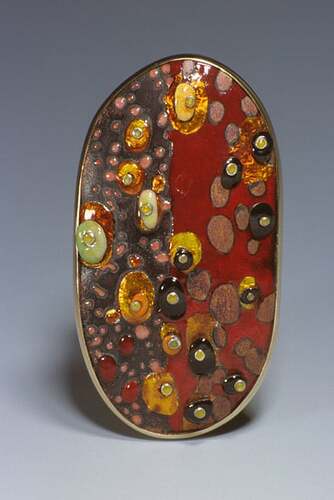Materials: Copper, silver, 18k yellow gold and enamel.
Dimensions: 0.3 X 1.75 X 2.27 inches
Photo credit: Karen Philippi
My work is inspired by my experiences, intermingling metalsmithing techniques and design with various artistic traditions from around the world. Inspired by the cultures I’ve encountered during my travels, I work with intrinsic materials, combining the traditional with the unexpected to elevate their status and reassign their function as jewelry.
My works explores the conceptual play of material and meaning. Travel photography and vintage snapshots serve as mementos that embody the present reality. In one group of pieces, photographs of architectural antiquity are transformed into body adornment. In another group, paper money used as an Asian ceremonial offering of currency for the dead, transcends its original function and serves as an evocation of metal and the sentiments of mourning. Through the juxtaposition of materials that may be perceived as incompatible, I combine the transparency of hot glue with the luster of silver to create a piece of subtle shifting color and texture. This intermingling of a lowly material and a precious metal elevates the perception of the hot glue through its encounter with the silver.
Pushing the boundaries of traditional techniques, I have experimented with materials such as inlaying Kingfisher bird feathers in unconventional ways as well as using unorthodox binding methods like melting monofilament. I have developed pieces through creative processes that connect mind and hand, and abstract ideas and tangible forms, in the medium of jewelry.
I also reference familiar symbols like the phoenix which are rearranged to create new silhouettes and meanings. Graphic elements, for instance, are layered to create textures, while old photographs may portray events but as well as a sense of action. Through these methods, I create new context.
My pieces are complete objects on their own but are enhanced when they are worn—they integrate with the wearer by reflecting and shadowing a person’s body and movements. This is a pivotal moment and expresses a creative continuum from the inception of a work to its material explorations to the dynamic experience of the jewelry on the human form.
The exhibition explores metal works whose primary theme is color embraced as their primary visual focus, whether that be using colored materials, exploring creating colored surfaces, or encasing the object in color.
As the world's largest jewelry related internet site, Ganoksin strives to develop exhibitions showcasing work from around the world. This exhibition was open to all metalsmiths, professional and amateur, advanced and beginner.
In total 303 artists contributed 814 show pieces for the permanent online exhibition.
The exhibition was curated by Beth Wicker, President of the North Carolina Society of Goldsmiths in the United States, and Adjunct Instructor at Northeastern Technical College in South Carolina. Director of the exhibition is Hanuman Aspler, founder of The Ganoksin Project, the world's largest internet jewelry site.
Hue is one of the primary properties of color, it refers to the place the color occupies on the visual spectrum. Humans have used hues throughout time, to create cave paintings, to decorate themselves, their clothing and their housing.
Different hues have taken on different meanings throughout time. Gold traditionally has been a color of purity - the metal gold is relatively unchangeable, and the hue of gold has come to stand for gods and goddesses, for royalty, for durability and for purity. Red has often meant love, or passion. Hues often reflect the meaning of the seasons, with pastels referring to spring and the burst of new life after the pale hues of winter. Summer is reflected in vibrant, deep hues, followed by the browning of hues in the fall as plants go to seed and die, and the land turns fallow.
The worth of a hue has often been tied to what is necessary to make the pigment that creates the hue, and the expensive involved in the process. Often created from crushed stones that had to be mined and carried by caravan over thousands of miles, or from fermented roots of plants only grown in certain areas, or the carapaces of rare insects - the creation of hue in a way that could be used by man was an involved and generally expensive process.
In today's world metalsmiths have access to perhaps the widest range of materials and hues in the history of man - and in some of the most affordable ways ever.
This exhibition celebrates hue - color - as an integral, inherent element of the work. We talk of the "richness" of color, and examples of this abound here. One expects hues from the colors of gemstones used in metalsmithing, but we also have hues from some less expected places. Glass enamels are an ancient way of adding color, as are a variety of patinas. Today's artists also use synthetic man-made materials to add color in ways that didn't exist a century ago.
We invite you to enjoy this celebration of hue, and the ways hues and their use have changed over time.
